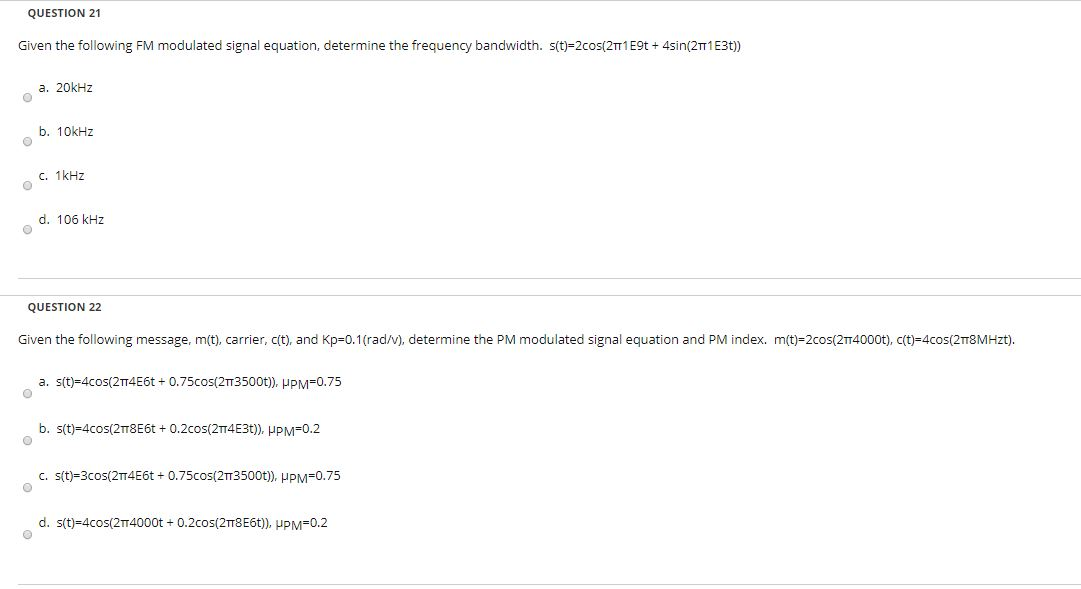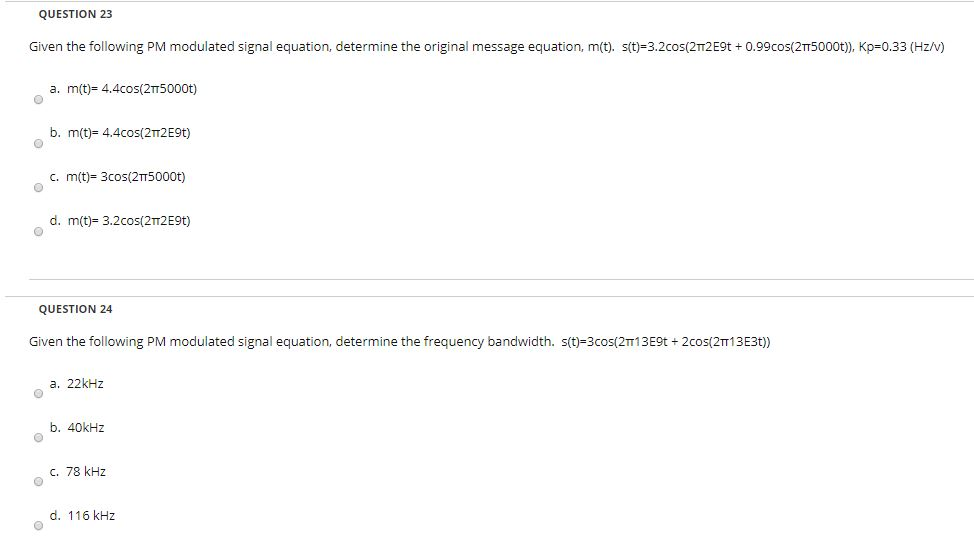



QUESTION 2 What is true regarding an information signal viewed in the time and frequency domains. a. the bandwidth of a signal can only be viewed in the time domain b. as a signal carries greater information, the signal's bandwidth can be seen to increase in the time domain c. as a signal carries greater information, the signal's bandwidth can be seen to increase in the frequency domain d. if you can view a signal in the time domain, then there is no need to view the signal in the frequency domain QUESTION 13 Given the following AM modulated signal, determine the occupied frequency bandwidth (note: assume double-sideband large carrier (DSB-LC): s(t) = 4[1 +0.95 cos(213000t)] cos(21100E9t) a. Frequency bandwidth = 3000 Hz b. Frequency bandwidth = 6000 Hz c. Frequency bandwidth = 100E9 Hz d. Frequency bandwidth = 200E9 Hz QUESTION 14 Given the following message and carrier equations, determine the AM modulated signal equation: m(t)=3cos(2114kHz*t), c(t)=2cos(213MHz*t) a. s(t)=3[1 + 0.67cos(2714000t)]cos(2173E6t) b. s(t)=2[1 + 1.5cos(2174000t)]cos(26T3E6t) C. s(t)=3[1 + 0.67cos(273E6t) cos(274kHz*t) d. s(t)=2[1 + 1.5cos(2173MHz*t)]cos(2174000t) QUESTION 21 Given the following FM modulated signal equation, determine the frequency bandwidth. s(t)=2cos(211E9t + 4sin(211 E3t)) a. 20kHz b. 10kHz C. 1kHz d. 106 kHz QUESTION 22 Given the following message, m(t), carrier, c(t), and Kp=0.1(rad/V), determine the PM modulated signal equation and PM index. m(t)=2cos(274000t), c(t)=4cos(2118MHzt). a. s(t)=4cos(2714E61 +0.75cos(2173500t)), HPM=0.75 b. s(t)=4c0s(2778E6t + 0.2cos(2174E3t)), HPM=0.2 C. s(t)=3cos(2714E6t +0.75cos(2173500t)). HPM=0.75 d. s(t)=4cos(2174000t +0.2cos(2178E6t)), UPM=0.2 QUESTION 23 Given the following PM modulated signal equation, determine the original message equation, m(t). s(t)=3.2cos(2172 E9t +0.99cos(2175000t)), Kp=0.33 (Hz/v) a. m(t)= 4.4cos(2775000t) b. m(t)= 4.4cos(2172E9t) c. m(t)= 3Cos(2775000t) d. m(t)= 3.2cos(212E9t) QUESTION 24 Given the following PM modulated signal equation, determine the frequency bandwidth. s(t)=3cos(213E9t + 2 cos(21713E3t)) a. 22kHz 40kHz c. 78 kHz d. 116 kHz QUESTION 2 What is true regarding an information signal viewed in the time and frequency domains. a. the bandwidth of a signal can only be viewed in the time domain b. as a signal carries greater information, the signal's bandwidth can be seen to increase in the time domain c. as a signal carries greater information, the signal's bandwidth can be seen to increase in the frequency domain d. if you can view a signal in the time domain, then there is no need to view the signal in the frequency domain QUESTION 13 Given the following AM modulated signal, determine the occupied frequency bandwidth (note: assume double-sideband large carrier (DSB-LC): s(t) = 4[1 +0.95 cos(213000t)] cos(21100E9t) a. Frequency bandwidth = 3000 Hz b. Frequency bandwidth = 6000 Hz c. Frequency bandwidth = 100E9 Hz d. Frequency bandwidth = 200E9 Hz QUESTION 14 Given the following message and carrier equations, determine the AM modulated signal equation: m(t)=3cos(2114kHz*t), c(t)=2cos(213MHz*t) a. s(t)=3[1 + 0.67cos(2714000t)]cos(2173E6t) b. s(t)=2[1 + 1.5cos(2174000t)]cos(26T3E6t) C. s(t)=3[1 + 0.67cos(273E6t) cos(274kHz*t) d. s(t)=2[1 + 1.5cos(2173MHz*t)]cos(2174000t) QUESTION 21 Given the following FM modulated signal equation, determine the frequency bandwidth. s(t)=2cos(211E9t + 4sin(211 E3t)) a. 20kHz b. 10kHz C. 1kHz d. 106 kHz QUESTION 22 Given the following message, m(t), carrier, c(t), and Kp=0.1(rad/V), determine the PM modulated signal equation and PM index. m(t)=2cos(274000t), c(t)=4cos(2118MHzt). a. s(t)=4cos(2714E61 +0.75cos(2173500t)), HPM=0.75 b. s(t)=4c0s(2778E6t + 0.2cos(2174E3t)), HPM=0.2 C. s(t)=3cos(2714E6t +0.75cos(2173500t)). HPM=0.75 d. s(t)=4cos(2174000t +0.2cos(2178E6t)), UPM=0.2 QUESTION 23 Given the following PM modulated signal equation, determine the original message equation, m(t). s(t)=3.2cos(2172 E9t +0.99cos(2175000t)), Kp=0.33 (Hz/v) a. m(t)= 4.4cos(2775000t) b. m(t)= 4.4cos(2172E9t) c. m(t)= 3Cos(2775000t) d. m(t)= 3.2cos(212E9t) QUESTION 24 Given the following PM modulated signal equation, determine the frequency bandwidth. s(t)=3cos(213E9t + 2 cos(21713E3t)) a. 22kHz 40kHz c. 78 kHz d. 116 kHz










